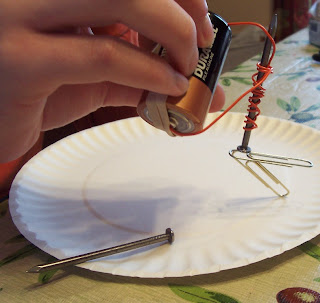 Make An Electromagnet
Make An Electromagnet- insulated copper wire
- rubber band
- "D" battery
- 2 large nails
- small paper clips
- wire stripper (or scissors)
- Cut a piece of wire about 40 cm long.
- Use a wire stripper (or scissors, carefully) to remove about 1 cm of insulation from the ends of the wire.
- Using the center of the wire, coil the wire around one nail, leaving about the same amount of wire on either side.
- Wrap the rubber band around the ends of the battery to hold the the wire in place.
- Connect the wires to the battery to create an electromagnet. Try to pick up paper clips and the other nail. Only keep the battery connected to the wires for 30 seconds.
- Touch the head of the nail after the circuit has been connected for 30 seconds to feel how the electrical current is making the metal heat up.
Electrical to Heat Energy
- batteries (we used pre-made "battery packs" with 4 AAs held together with tape and rubber bands and connected + to - with wires)
- small lightbulb (we used one from an electrical set which came with wires)
- compass
- Connect the lightbulb to the batteries using the wires.
- Leave it lit for 15 seconds and feel the bulb heat up.
- Using the compass, see if you can detect the magnetic field generated by the electrical energy traveling through the wire.

